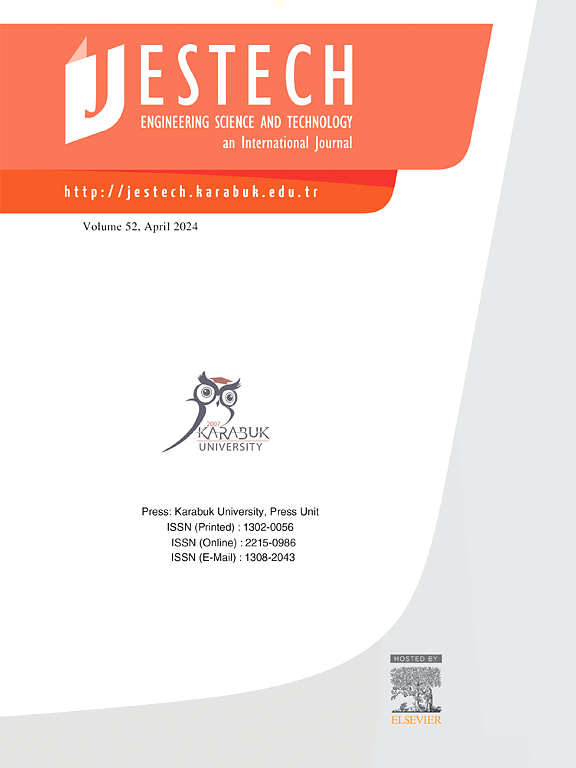TDSF: Two-phase tamper detection in semi-fragile watermarking using two-level integer wavelet transform
IF 5.1
2区 工程技术
Q1 ENGINEERING, MULTIDISCIPLINARY
Engineering Science and Technology-An International Journal-Jestech
Pub Date : 2025-01-01
DOI:10.1016/j.jestch.2024.101909
引用次数: 0
Abstract
Image watermarking is one of techniques that can be used to protect and recover from the altered images. Tamper detection in semi-fragile still does not achieve high accuracy for tamper localization, especially in malicious attacks. This study proposes two-phase tamper detection in semi-fragile image watermarking using two-level Integer Wavelet Transform (IWT). The study proposes two-phases of tamper detection to achieve a high level of accuracy in the tamper localization. The initial phase will check four segments to determine the tampered bit or not. A tampered segment is identified if it contains at least one tampered bit. The second phase will be performed if the first phase has no tampered bit. The second phase checked each segment to determine whether it was tampered with or not. This study also used Normalized Hamming Similarity (NHS) to classify malicious and incidental attacks. The proposed scheme performed two-level integer wavelets transform to obtain the LL, LH, HL, and HH sub-bands. The authentication bits of LL are embedded into the LH and HL sub-bands to generate a watermarked image. The LH and HL are compared using XOR bitwise with authentication bit to localize the tamper detection. The experimental results show that the proposed scheme achieved high quality of the recovered images with an average PSNR score of 44.1864 dB, wPSNR score of 46.2218 dB and SSIM score of 0.9945. The proposed method produced high accuracy of tamper detection of about 98.33 % under object manipulation with the tampering rate of about 12.1643 %.
求助全文
约1分钟内获得全文
求助全文
来源期刊

Engineering Science and Technology-An International Journal-Jestech
Materials Science-Electronic, Optical and Magnetic Materials
CiteScore
11.20
自引率
3.50%
发文量
153
审稿时长
22 days
期刊介绍:
Engineering Science and Technology, an International Journal (JESTECH) (formerly Technology), a peer-reviewed quarterly engineering journal, publishes both theoretical and experimental high quality papers of permanent interest, not previously published in journals, in the field of engineering and applied science which aims to promote the theory and practice of technology and engineering. In addition to peer-reviewed original research papers, the Editorial Board welcomes original research reports, state-of-the-art reviews and communications in the broadly defined field of engineering science and technology.
The scope of JESTECH includes a wide spectrum of subjects including:
-Electrical/Electronics and Computer Engineering (Biomedical Engineering and Instrumentation; Coding, Cryptography, and Information Protection; Communications, Networks, Mobile Computing and Distributed Systems; Compilers and Operating Systems; Computer Architecture, Parallel Processing, and Dependability; Computer Vision and Robotics; Control Theory; Electromagnetic Waves, Microwave Techniques and Antennas; Embedded Systems; Integrated Circuits, VLSI Design, Testing, and CAD; Microelectromechanical Systems; Microelectronics, and Electronic Devices and Circuits; Power, Energy and Energy Conversion Systems; Signal, Image, and Speech Processing)
-Mechanical and Civil Engineering (Automotive Technologies; Biomechanics; Construction Materials; Design and Manufacturing; Dynamics and Control; Energy Generation, Utilization, Conversion, and Storage; Fluid Mechanics and Hydraulics; Heat and Mass Transfer; Micro-Nano Sciences; Renewable and Sustainable Energy Technologies; Robotics and Mechatronics; Solid Mechanics and Structure; Thermal Sciences)
-Metallurgical and Materials Engineering (Advanced Materials Science; Biomaterials; Ceramic and Inorgnanic Materials; Electronic-Magnetic Materials; Energy and Environment; Materials Characterizastion; Metallurgy; Polymers and Nanocomposites)
 求助内容:
求助内容: 应助结果提醒方式:
应助结果提醒方式:


